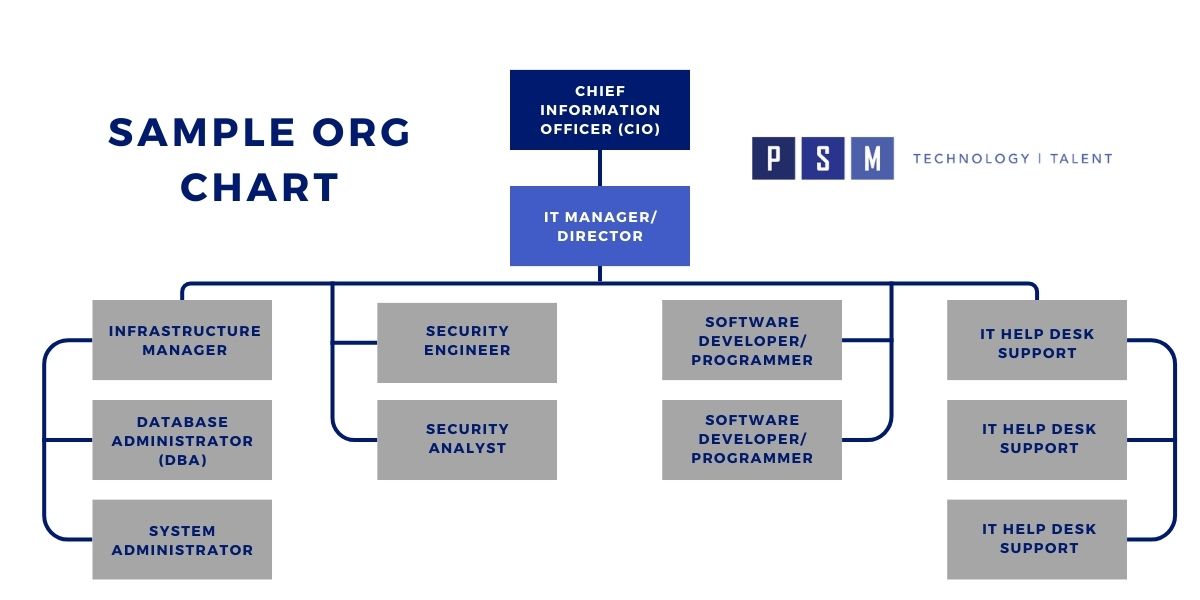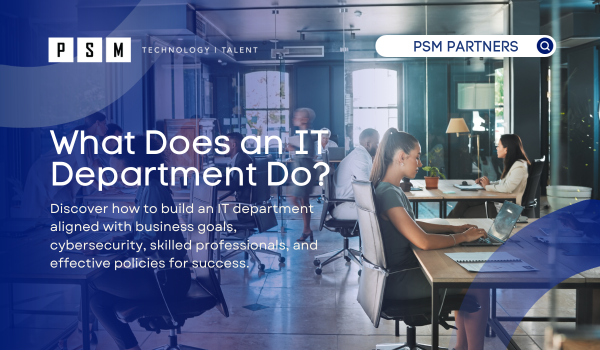Table of Contents
ToggleIT teams often exhibit significant variations from one business to another. The composition and duties of your IT department are influenced by various elements, including company size, business objectives, industry-specific compliance demands, and cybersecurity vulnerabilities.
Nevertheless, there are certain key roles and responsibilities that all IT leaders should consider, regardless of whether they are establishing a new IT department or contemplating a reorganization of their existing resources.
What is an IT Department
An IT (Information Technology) department is a crucial component of an organization responsible for managing and maintaining its technological infrastructure and systems. The primary role of an IT department is to ensure that the organization’s technology resources are utilized efficiently, securely, and in line with the company’s goals and objectives.
The specific structure and responsibilities of an IT department can vary widely depending on the size and nature of the organization. In larger organizations, the IT department may be divided into specialized teams or units, such as network administration, cybersecurity, database management, and user support, each focusing on a specific aspect of technology management. In smaller organizations, IT responsibilities may be handled by a smaller team or even a single IT professional.
What Does the IT Department Do?
1. Infrastructure Management
Managing and maintaining the organization’s hardware infrastructure, including servers, networking equipment, computers, and mobile devices. This involves ensuring the physical components are operational, performing routine maintenance, and planning for hardware upgrades or replacements as needed.
2. Software Management
Installing, configuring, and maintaining software applications and operating systems used by the organization. This includes updating and patching software to ensure security and functionality, as well as managing software licenses and optimizing software usage.
3. User Support
Providing technical support to employees or users within the organization. This includes helping them with hardware and software issues, troubleshooting problems, and offering guidance on using technology effectively. User support ensures that employees can work efficiently with the organization’s IT resources.=
4. Data Management
Ensuring the security, availability, and integrity of the organization’s data. This includes implementing data backup strategies, creating data recovery plans, and establishing data protection measures to safeguard sensitive information from loss or unauthorized access.
5. Cybersecurity
Protecting the organization’s digital assets from cyber threats, such as viruses, malware, ransomware, and unauthorized access. This involves implementing security measures like firewalls, intrusion detection systems, and regular security audits to mitigate risks and ensure data confidentiality and system integrity.
6. Network Management
Managing the organization’s computer networks, including local area networks (LANs) and wide area networks (WANs). This includes ensuring reliable connectivity, optimizing network performance, and monitoring network security threats to maintain uninterrupted communication and data flow.
7. Hardware and Software Procurement
Selecting and purchasing hardware and software solutions that meet the organization’s needs while staying within budget constraints. This involves evaluating technology options, negotiating with vendors, and ensuring that purchased resources align with the organization’s IT strategy.
8. IT Policy and Compliance
Developing and enforcing IT policies and procedures to ensure that the organization’s technology use aligns with legal and regulatory requirements, as well as industry best practices. This helps mitigate risks and ensure responsible and ethical IT usage.
9. Strategic Planning
Collaborating with other departments to align IT strategies with the organization’s overall business objectives. This may involve identifying opportunities to leverage technology for competitive advantage, as well as long-term planning to ensure technology investments support the organization’s growth and goals.
10. Training and Education
Providing training and educational resources to employees to enhance their technology skills and promote efficient and secure technology usage. This ensures that staff members are equipped with the necessary knowledge and skills to effectively utilize IT resources.
It Department Roles and Responsibilities
These roles and responsibilities may vary depending on the size and complexity of the organization’s IT department, as well as its specific industry and technology needs. Larger organizations may have more specialized roles, while smaller organizations may combine responsibilities into fewer positions.
1. Chief Information Officer (CIO)
The Chief Information Officer (CIO) plays a pivotal role in the organization, overseeing the entire IT department. They are responsible for aligning the IT strategy with the broader business goals, ensuring that technology investments contribute to the organization’s objectives. The CIO also manages the IT budget, making critical decisions about resource allocation and investment priorities. They drive innovation, identify emerging technology trends, and guide the organization toward leveraging technology effectively for a competitive advantage.
2. IT Manager/Director
The IT Manager or Director is the linchpin of daily IT operations. They are responsible for managing the day-to-day activities of the IT department, which includes supervising IT staff and teams. Additionally, they play a pivotal role in developing and implementing IT policies and procedures that govern how technology resources are used within the organization. One of their key responsibilities is ensuring that IT projects are executed on time and within budget, delivering value to the business.
3. Infrastructure Manager
The Infrastructure Manager is responsible for maintaining and enhancing the organization’s hardware infrastructure. This entails overseeing the upkeep of servers, networking equipment, and data centers. They are also tasked with ensuring the reliability and availability of the network, allowing for seamless business operations. In addition, the Infrastructure Manager plans for scalability to accommodate growth and formulates disaster recovery strategies to safeguard against potential disruptions.
4. IT Help Desk Support
IT Help Desk Support plays a critical role in providing technical assistance to end-users. They manage the helpdesk, which serves as the front line for addressing hardware and software issues faced by employees. Beyond issue resolution, they play a proactive role by conducting user training programs, empowering staff to efficiently use technology resources, and minimizing disruptions caused by technical challenges.
5. Database Administrator (DBA)
The Database Administrator (DBA) specializes in managing and optimizing databases, ensuring the secure storage and retrieval of critical data. They are responsible for maintaining data integrity, performing routine backups, and implementing recovery procedures. DBAs work closely with developers and other teams to ensure that databases perform optimally and can support the organization’s data-driven initiatives.
6. System Administrator
System Administrators are responsible for managing the organization’s server and system infrastructure. This includes tasks such as user account management, ensuring system performance meets requirements, and tuning systems for optimal operation. They monitor systems for issues, troubleshoot problems, and ensure that essential services remain available to support business operations.
7. Security Analyst/Security Engineer
Security Analysts or Security Engineers are dedicated to safeguarding the organization’s digital assets. They are responsible for monitoring security threats, conducting security assessments, and implementing a range of security controls and measures. This includes activities such as firewall management, intrusion detection, and ensuring compliance with security policies and regulations.
8. Software Developer/Programmer
Software Developers and Programmers are integral to building custom software applications that meet the specific needs of the organization. They are involved in the full software development lifecycle, from coding and testing to deploying software solutions. Collaboration with end-users is essential, as they work together to gather requirements and create software that enhances operational efficiency and supports business processes.
Furthermore, within more extensive IT department setups, there may be dedicated teams with specialized expertise in fields such as data analytics, cloud computing, and project management.

What to Consider When Building an IT Department for Your Business?
When establishing an IT department, prioritize aligning technology with business goals, allocate resources wisely, ensure cybersecurity and compliance, recruit skilled professionals, select appropriate technology solutions, implement effective policies, foster vendor relationships, train employees, monitor performance, and plan for future scalability. Successful IT integration is essential for long-term business success and innovation.
Can You Outsource Your IT Department?
Yes, you can outsource your IT department. Many businesses choose to partner with Managed Service Providers (MSPs) or IT consulting firms to handle various IT functions. This approach allows companies to access specialized expertise, reduce costs, and focus on their core business activities while leaving IT management and support to external professionals. The extent of outsourcing can vary, from specific tasks or projects to complete IT department management.
What Can PSM Do?
PSM Partners is your trusted ally for IT department requirements. As an MSP and IT Consulting Company, we’re here to support you, regardless of project size or day-to-day needs. We’re dedicated to safeguarding your network and managing your business effectively. To learn more, give us a call at (312) 940-7830.

